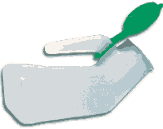Role of PTA in Treating Conditions associated with GU Disorders
- Patients may often confide GU complaints, and signs and symptoms of GU dysfunction to PT/PTA
- The patient's medical care providers may be unaware of patient GU complaints
- The PTA needs to
- Document patient complaints and communicate patient complaints to PT
- Maintain neutral communication and take care to engender trust and open communication
- Patient. may need support and education in the use of equipment and supplies to prevent social isolation and disability
- Patient may need education in the role of incontinence in contributing to their own decline in function and mobility
- Be aware of new or progressive complaints of acute flank pain (posterior trunk) or low back pain of non medical origin
- Consult with primary PT and refer back to primary care provider (PCP) as indicated
- Monitor BP due to additional stress on kidney function with urinary disorders
- Assist in positioning pt. out of supine to decrease stress on kidneys.
- Assist healthcare team with fluid input and output monitoring during patient encounters. May include assisting with urine collections "hat" and catheters before disposing/flushing of toilet. Communicate with CNA/RN regarding pt fluid intake and output.

- Monitor catheter position at bedside and during PT to prevent reflux into bladder: maintain gravity assisted positioning.
- Instruct pt's in airway clearance and mobility post-op GU surgery
- Modify activities according to pt response with ambulation following surgery such as prostate resection.
- No abdominal crunches or high impact exercises post op
- No abdominal crunches or high impact exercises in women with GU dysfunction
- Instruct in kegel exercises
- Instruct in abdominal and dynamic pelvic floor exercises with hip external rotation and abduction as prescribed by PT
- Instruct in body mechanics, pacing and prioritizing for proper lifting when cleared by physician.
- Modalities with advanced training outside of our PTA program for pelvic floor muscle re-education, biofeedback, autonomic nervous system self-monitoring
- Maintain neutral presence with pt disclosure of sexual abuse/dysfunction, maintain pt confidentiality and dignity.
- Communicate with PT when above conversation(s) disclosures about sexual abuse occur during treatment.
- Avoid assumptions about sexual activity or sexual orientation during patient education; use culturally neutral language when discussing patient-led concerns about sexual dysfunction as it relates to PT plan of care.
toc | return to top | previous page | next page
